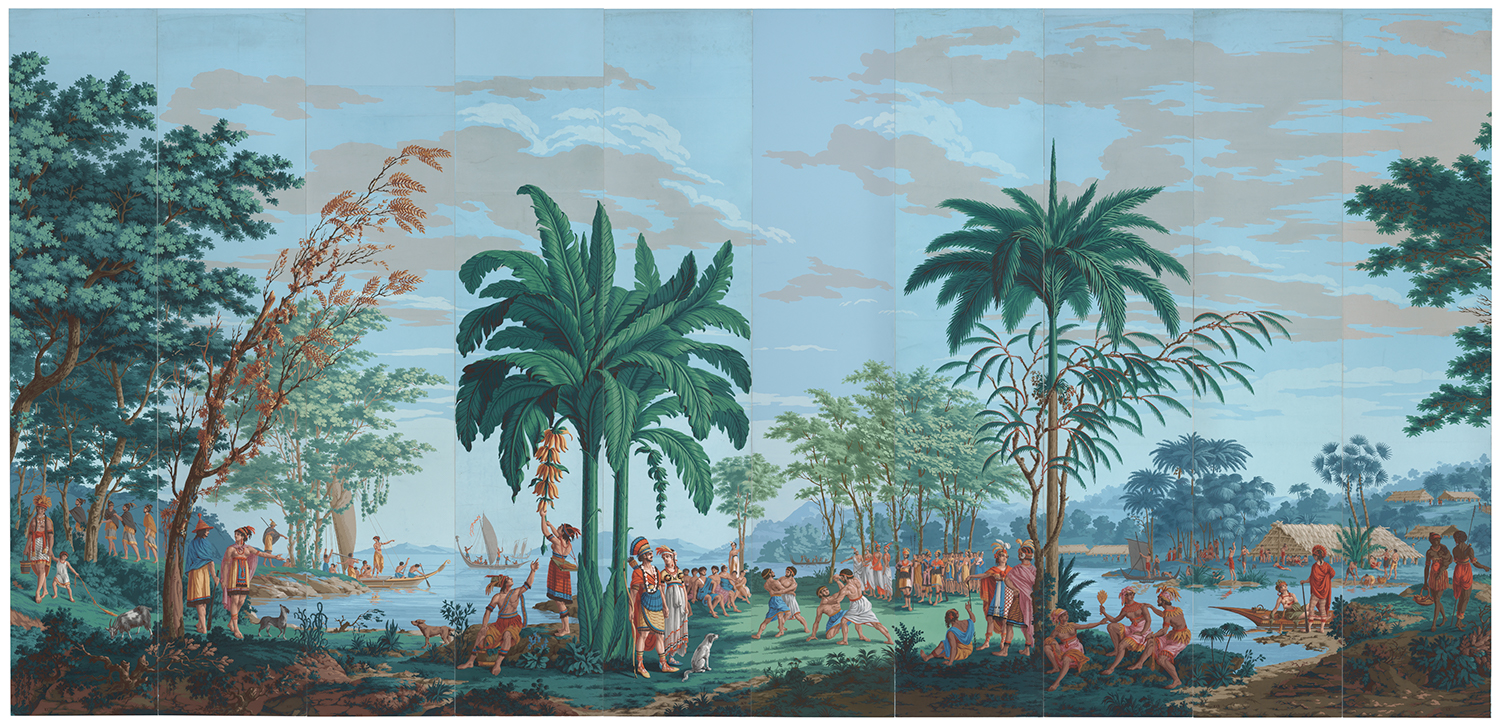Les Sauvages de la Mer Pacifique, a large 19th-century wallpaper at the de Young Museum, depicts a romanticized version of British Captain James Cook’s three expeditions to the Pacific, and primarily Polynesia. At over 17 feet long, the scene portrays happy people lounging, dancing and unhurriedly working in a verdant tropical setting.
And though each of the 20 panels is meant to represent different locales from Cook’s journeys, the continuous landscape does not readily present the distinction between people and places, not least of all because designer Jean-Gabriel Charvet drew on attire from classical antiquity and the French Empire period when illustrating the people of the Pacific. This results in a scene that is ahistorical even before considering history. The greatest distortion, however, is the artist’s failure to represent the violence and colonization that Cook and the British brought to the Pacific.
After chancing upon the wallpaper in an Australian museum, Lisa Reihana, a Māori artist from New Zealand, embarked on a decade-long project to reimagine Les Sauvages de la Mer Pacifique by infusing it with the truth that it lacks.

The result is stunning. Reihana’s in Pursuit of Venus [infected], on view at the de Young until Jan. 5, takes the form of an immersive video that scrolls along a 70-foot screen. The illustrated background is much like Charvet’s, lending an animated feel to the video, but Reihana’s update is populated with a filmed cast of more than 100 characters and performers, all integrated beautifully and seamlessly into the landscape.
Though the video loops back on itself and has no definite beginning or end, there is a narrative progression. Prior to Cook’s arrival, the locals are shown living a life not too unlike that depicted by Charvet—they appear happy and fulfilled. Immediately following the arrival of the explorers, the various groups appear to get along relatively well. But minor hostility on the part of the British quickly devolves into the torture and subjugation of the locals, culminating in the killing of Cook as he tries to kidnap Kalaniʻōpuʻu, the ruler of Hawaiʻi (a true story).
![Lisa Reihana, detail 'in Pursuit of Venus [infected],' 2015–17.](https://ww2.kqed.org/arts/wp-content/uploads/sites/2/2019/08/in-Pursuit-of-Venus-infected-2015-17-STILL-05_1200.jpg)
Tellingly, the first act of violence depicted isn’t a member of Cook’s crew attacking one of the locals, but rather a member of the expedition whipping his comrade. In early scenes the locals are seen tattooing British men, helping them apply body paint, and entertaining them, such as with a comedic mock childbirth with a grown man playing the part of the baby. And while Cook and his crew seem friendly enough at first, the whipping of one of their own breaks the peace—an anticipated inevitability for students of history—and suggests that while they have met with hospitality, the British have brought their own violence and inherited trauma to the Pacific.

![Lisa Reihana, Installation view of 'in Pursuit of Venus [infected],' at de Young Museum, 2019.](https://ww2.kqed.org/arts/wp-content/uploads/sites/2/2019/08/2019_DEY_LIsaReihana_V25.jpg)


